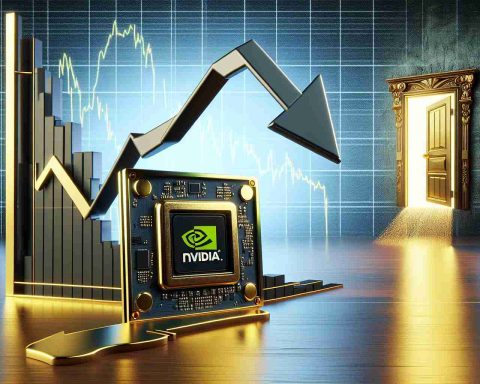- Nvidia’s stock fell nearly 5% due to escalating tech industry turmoil following President Trump’s tariff announcements.
- A 10% tariff on imports from China and 25% on goods from Mexico and Canada has rattled investors and caused the Nasdaq to drop over 2%.
- Concerns over tighter U.S. export regulations on critical chips, particularly with 17% of Nvidia’s 2024 sales expected from China, have intensified uncertainty.
- The introduction of a competing AI model by Chinese firm DeepSeek contributed to a significant sell-off, leading to a dramatic 17% decline in Nvidia’s stock value.
- Analysts are concerned that increased tariffs may raise costs for data processing equipment, potentially reducing demand for Nvidia’s offerings.
In a stunning turn of events, Nvidia’s stock plummeted nearly 5% amid rising turmoil in the tech world sparked by President Trump’s unexpected tariffs. The announcement of a 10% tariff on Chinese imports and a hefty 25% on goods from Mexico and Canada left investors reeling, pushing the Nasdaq down over 2% in early trading.
Nvidia had already been on shaky ground due to concerns surrounding tighter U.S. export regulations on its chips destined for China. Recent reports indicated the government was contemplating further restrictions on the company’s latest H20 chips, essential for compliance with U.S. trade regulations. With 17% of Nvidia’s anticipated sales for 2024 coming from China, this uncertainty hit hard.
The situation was exacerbated by the launch of a competitive AI model from the Chinese firm DeepSeek, leading to a historic sell-off in the tech sector. Nvidia bore the brunt of this plunge, suffering a staggering 17% loss in a single day that wiped out a jaw-dropping $589 billion from its market cap.
Analysts warn that although semiconductors are not directly impacted by the new tariffs, these measures could inflate costs for data processing equipment like servers utilizing AI chips. With imports from China hitting $39 billion in 2023 and those from Mexico at $28 billion, the ripple effects of these tariffs could dampen demand for Nvidia’s products.
As the tech landscape continues to shift, investors are left to navigate the choppy waters ahead—will Nvidia’s fortunes rebound, or is this just the beginning? Stay tuned!
The Nvidia Stock Saga: A Dive into Current Challenges and Future Trends
Understanding the Current Landscape for Nvidia
Nvidia recently faced a significant decline in its stock price, dropping nearly 5% amid escalating tensions in the tech industry largely driven by unexpected tariffs imposed by the Trump administration. These tariffs specifically target Chinese imports with a 10% surcharge, while imposing 25% on goods from Canada and Mexico. As a result, the Nasdaq composite index fell over 2% early in trading.
New Developments and Insights
1. Market Trends and Innovations:
– Emerging AI Competition: With the introduction of DeepSeek’s AI model, Nvidia is no longer the sole leader in this space. The competitive landscape is intensifying, and investors are wary of market share erosion.
2. Limitations and Regulatory Issues:
– U.S. Export Regulations: There are increasing restrictions proposed on Nvidia’s H20 chips, essential for complying with U.S. trade policies, particularly concerning China. Approximately 17% of Nvidia’s anticipated sales in 2024 are projected to stem from the Chinese market, heightening concerns over future revenue streams.
3. Impact of Tariffs on Operational Costs:
– Cost Implications: Analysts indicate that while semiconductors might not be directly affected by the tariffs, the overall cost for data processing equipment utilizing AI chips could rise. This is crucial as Nvidia’s user base includes enterprises reliant on cost-effective solutions.
Key Questions and Answers
Q1: How can Nvidia mitigate the impact of tariffs on its sales?
A1: Nvidia can consider diversifying its supply chains and sourcing materials from countries not affected by these tariffs. Additionally, it may look at increasing its local manufacturing capabilities to buffer against international market fluctuations.
Q2: What are the potential long-term effects of export restrictions on Nvidia?
A2: Prolonged export restrictions can significantly impact Nvidia’s foothold in the rapidly growing Chinese AI market. Consequent revenue loss could hamper investment in research and innovation, ultimately affecting their competitive edge.
Q3: How might Nvidia’s positioning change in the face of growing AI competition?
A3: Nvidia may need to innovate faster and enhance its product offerings in AI to maintain its market leadership. Collaborations with other tech firms and investments in cutting-edge technology (like quantum computing) could play a vital role in its strategic response.
Pricing and Market Analysis
– Recent Price Movements: Following the launch of competing products, Nvidia’s market cap saw a staggering $589 billion drop.
– Future Projections: Analysts are divided on Nvidia’s recovery trajectory, but many suggest volatility will remain prevalent in the tech sector influenced by geopolitical factors.
Conclusion: The Road Ahead
As the tech industry grapples with economic and political turbulence, Nvidia’s future hinges on its ability to navigate these challenges. The need for adaptability and innovation has never been more pronounced. Keep an eye on this evolving narrative as we analyze trends and market forecasts in the tech world.
For more in-depth analysis and updates on Nvidia and the tech sector, visit Nvidia’s official site.





















